ESP BUICK SKYLARK 1993 Owners Manual
[x] Cancel search | Manufacturer: BUICK, Model Year: 1993, Model line: SKYLARK, Model: BUICK SKYLARK 1993Pages: 306, PDF Size: 15.84 MB
Page 28 of 306
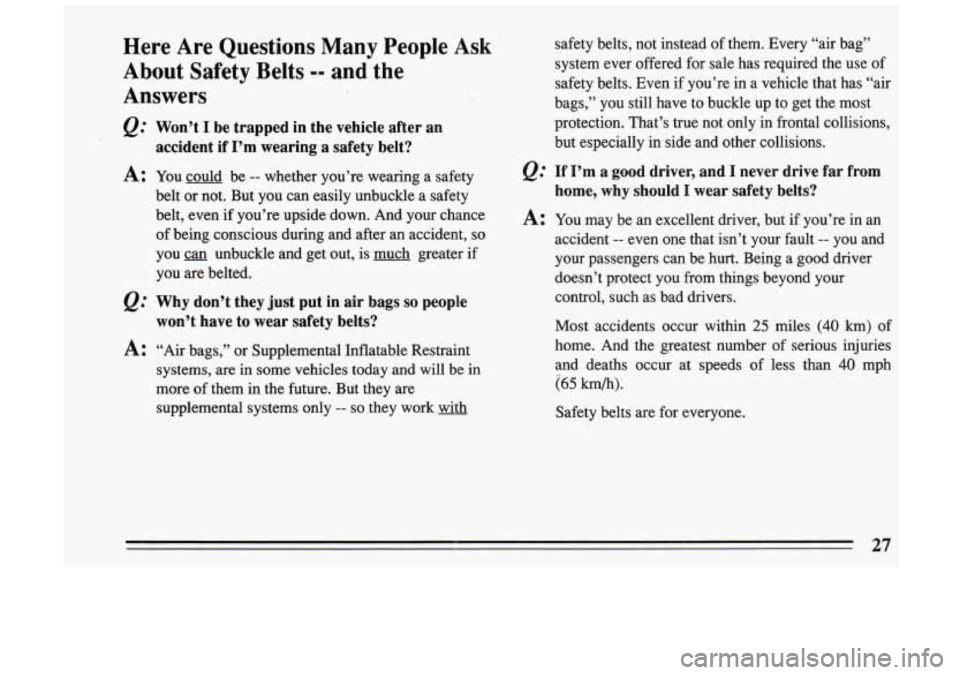
Here Are Questions Many People Ask
About Safety Belts
-- and the
Answers
Won’t I be trapped in the vehicle after .an
accident if I’m wearing a safety belt?
A: You could be -- whether you’re wearing a safety
belt or not. But you can easily unbuckle a safety
belt, even
if you’re upside down. And your chance
of being conscious during and after an accident, so
you unbuckle and get out, is much greater if
you are belted.
Q: Why don’t they just put in air bags so people
A: “Air bags,” or Supplemental Inflatable Restraint
won’t have to wear safety belts?
systems, are in some vehicles today and will be in
more of them in the future. But they are
supplemental systems only
-- so they work with safety belts, not instead
of them. Every “air
bag’’
system ever offered for sale has required the use of
safety belts. Even if you’re in a vehicle that has “air
bags,” you still have
to buckle up to get the most
protection. That’s true not only in frontal collisions,
but especially in side and other collisions.
&: If I’m a good driver, and I never drive far from
A: You may be an excellent driver, but if you’re in an,
accident
-- even one that.isn’t your fault -- you and
your passengers can be hurt. Being a good driver
doesn’t protect you from things beyond your
control, such as bad drivers.
home, why should I wear safety belts?
Most accidents occur within 25 miles (40 km) of
home. And the greatest number of serious injuries
and deaths occur at speeds
of less than 40 mph
(65 km/h).
Safety belts are for everyone.
27
Page 71 of 306
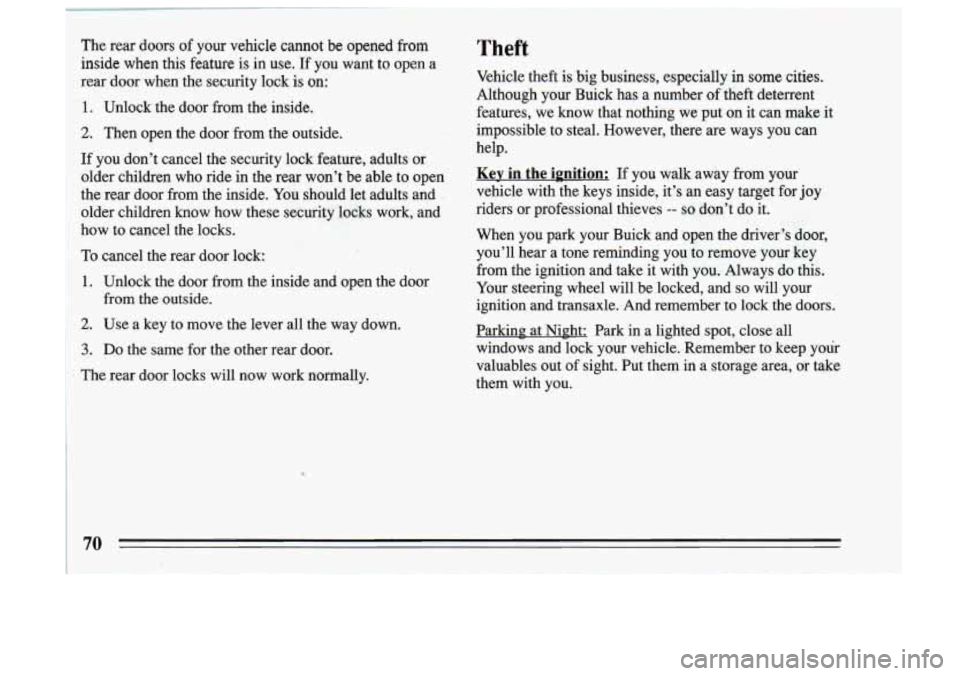
The rear doors of your vehicle cannot be opened from
inside when this feature is in use. If you want to open a
rear door when. the security lock is on:
1. Unlock the door from the inside..
2. Then open the door from the outside.
If you don’t cancel the security lock feature, adults or
older children who ride in the rear won’t be able to open
the rear door from the inside. You should let adults and
older children know how these security locks work, and
how to cancel the locks.
To cancel the rear door lock:
1. Unlock the door from the inside and open the door
2. Use a key to move the lever all the way down.
from the outside.
3. Do the
same for the other rear door.
. The rear door locks will now work norinally.
Theft
Vehicle theft is big business, especially in some cities.
Although your Buick has a number
of theft deterrent
features, we know that nothing we put on it can make it
impossible to steal. However, there are ways you can
help.
Kev in the ipnition: If you walk away from your
vehicle with the keys inside, it’s an easy target for
joy
riders or professional thieves -- so don’t do it. . .) ..
When you park your Buick and open the driver’s’a*oor,
you’ll hear a tone reminding you to remove your key
from the ignition and take it with you. Always do this.
Your steering wheel will be locked, and
so will your
ignition and transaxle. And remember to lock the doors.
: .+.,-:.,: <::: ., .,<. , p,
Parking at Night: Park in a lighted spot, close all
windows and lock your vehicle. Remember to keep your
valuables out of sight. Put them in a storage area,
or take
them with you.
Page 87 of 306

Adjustable Ride Control System
(Option)
adjusts to a medium ride.
0 Sport - This provides a firm, sporty ride with
This suspension system option allows the driver to
adjust the ride comfort according to road conditions.
To select a ride comfort option, push one of these three
1 buttons:
i Soft - This provides a smooth, comfortable ride.
0 Auto - This setting automatically adjusts the system.
While traveling at speeds under
47 mph (75 km/h),
the system will adjust to the soft ride. Traveling at
speeds faster than
47 mph (75 km/h) the system
responsive handling and cQrnering.
When Auto or
Soft is selected, the system begins in the
Sport mode. It will also automatically change back to
the Sport mode when the vehicle _---lkes anabrupt start,
stop or a sharp turn.
The indicator lights for all the buttons will come on for about
5 seconds after the ignition is started as a system
check.
If all the indicator lights come on and stay on,
there may be a problem.
You should have your vehicle
inspected.
Page 91 of 306

Ihrn Signal tCONSS Chime
A chime will sound if your turn signal is left on after
having gone
3/4 of a mile, to remind you to turn your
signal
off.
Operation of Lights
Although your vehicle’s lighting system (headlights,
parking lights, fog lamps, side.marker lights and
taillights) meet all applicable federal lighting
requirements, certain states and provinces may apply their own lighting regulations that may require special
attention before you operate these lights. For example,
some jurisdictions may require that you operate your
lower beam lights with fog lamps at all times, or that
headlights be turned on whenever you must use your
windshield wipers. In addition, most jurisdictions
prohibit driving solely with parking lights, especially at
dawn or dusk. It
is recommended that you check with
you own state or provincial highway authority for
applicable lighting regulations.
Headlight High-Low Beam
To change the headlights
from low beam to high or
high to low, pull the turn
signal lever all the way
toward you. Then release it.
When the high beams are
on, this blue light on the
instrument panel also will
be on.
Flash-To-Pass Feature
It lets you use your high beam headlights to signal a driver in front of you that you want to pass. It works
even
if your headlights are off.
To use it, pull the multifunction lever toward you a little
(but not
so far that you hear a click).
If your headlights are off Your high beam headlights
will
turn on. They’ll stay on as long as you hold the
lever there. Release the lever to turn them
off.
90
I
Page 100 of 306
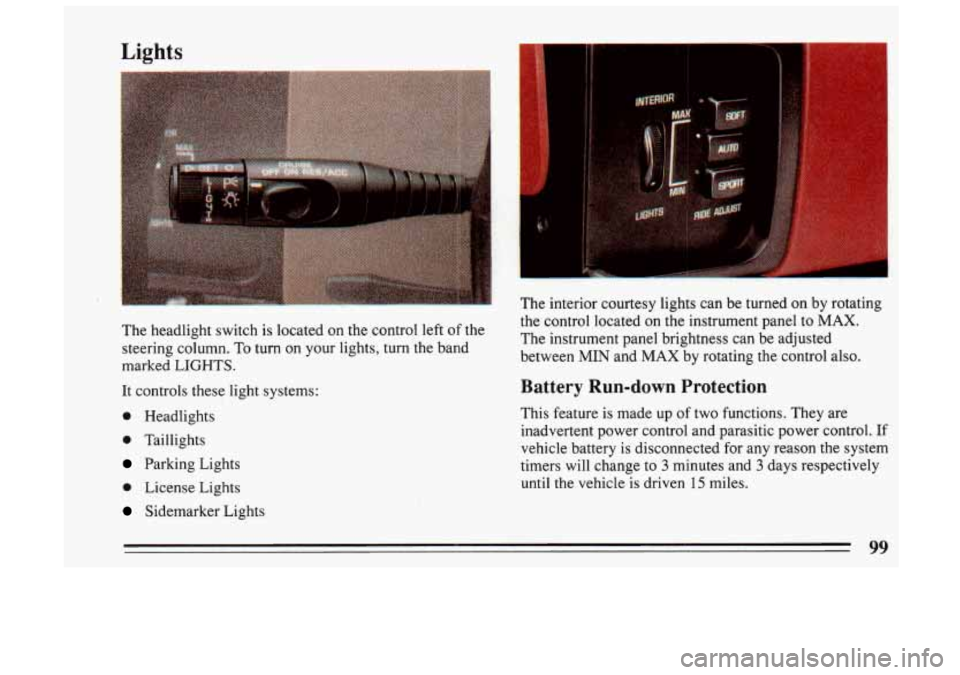
Lights
The headlight switch is located on the control left of the
steering column. To turn on your lights, turn the band
marked LIGHTS.
It controls these light systems:
0 Headlights
0 Taillights
Parking Lights
0 License Lights
Sidemarker Lights The interior courtesy lights can be turned on by rotating
the control located
on the instrument panel
to MAX.
The instrument panel brightness can be adjusted
between MIN and MAX by rotating the control also.
Battery Run-down Protection
This feature is made up of two functions. They are
inadvertent power control and parasitic power control. If
vehicle battery is disconnected for any reason the system
timers will change to
3 minutes and 3 days respectively
until the vehicle is driven 15 miles.
77
Page 123 of 306

I’ not cover thisdamage. And don’t put decals
Air Conditioner (Option)
The air conditioner cools the air coming into your
vehicle. The air conditioner won’t .work, well unless all
the windows are closed. On a very hot day, you might
want to open the windows to let the hottest air out.
Max
This setting provides maximum cooling with the least
amount of work. MAX recirculates the air inside your
vehicle, and cools the air quickly. Adjust the
temperature control to a cold setting.
Norm.
After using the MAX setting to cool the air quickly,
adjust the air conditioner to NORM and the temperature
to the desired comfort setting. This permits fresh air to
be cooled and to circulate through your vehicle.
Audio Systems
Your Delcoa audio system has been degigned to operate
easily and give years
of listening pleasure. But you will
get the most enjoyment out
of your system if you
acquaint yourself with it first. Find out what your
Delcom system can do and how to operate all its
controls,
to be sure you’re getting the most out of the
advanced engineering that went into it.
FM Stereo
FM stereo will give you the best sound. But FM signals
will reach only about
10 to 40 miles (16 to 65 km). And,
tall buildings or hills can interfere with FM signals, causing the sound to come and go.
AM
The range for most AM stations is greater than for FM,
especially at night. The longer range, however, can
cause stations to interfere with each other. AM can pick
up noise from things like storms and power lines.
Try
reducing the treble to reduce this noise.
122
1
Page 126 of 306
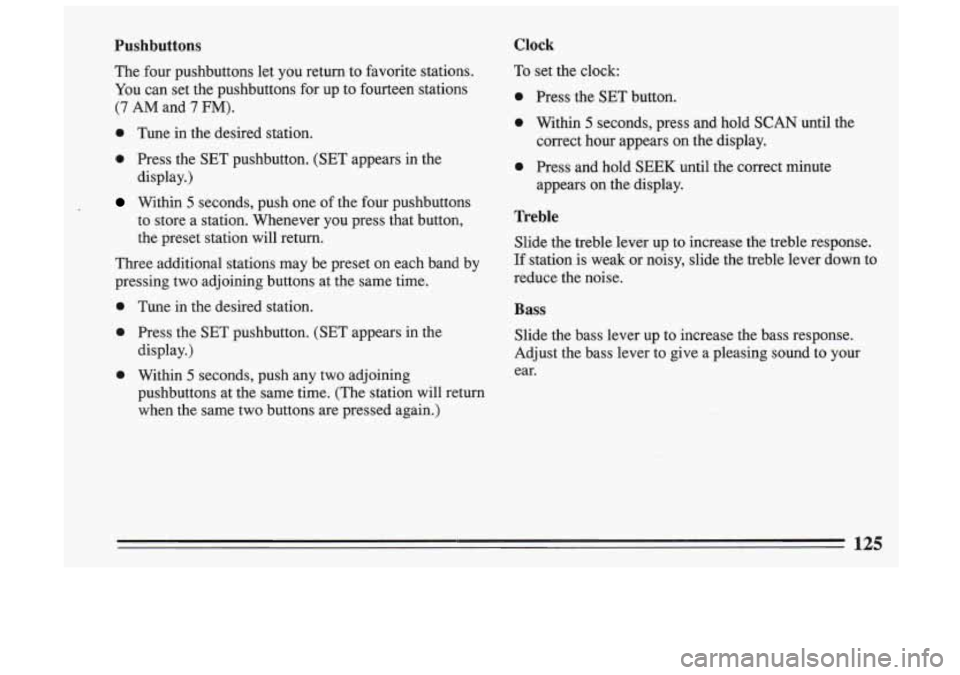
Pushbuttons
The four pushbuttons let you return to favorite stations.
You can set the pushbuttons for up to fourteen stations
(7 AM and 7 FM).
0 Tune in the desired station.
0 Press the SET pushbutton. (SET appears in the
display.)
Within 5 seconds, push one of the four pushbuttons
to store a station. Whenever you press that button,
the. preset station will return.
Three additional stations may be preset on each band by
pressing two adjoining buttons at the same time.
0 Tune in the desired station.
0 Press the SET pushbutton. (SET appears in the
0 Within 5 seconds, push any two adjoining
display.)
pushbuttons at the same time. (The station will return
when the same two buttons are pressed again.)
Clock
To set the clock:
0 Press the SET button.
0 Within 5 seconds, press and hold SCAN until the
correct hour appears on the display.
0 Press and hold SEEK until the correct minute
appears on the display.
Treble
Slide the treble lever up to increase the treble response.
If station is weak or noisy, slide the treble lever down to
reduce the noise.
Bass
Slide the bass lever up to increase the bass response.
Adjust the bass lever to give a pleasing sound
to your
ear.
Page 128 of 306

0 Tune in the station you want.
e Press the SET pushbutton. (SET appears in the
display.)
0 Within 5 seconds, push one of the four pushbuttons
to store the station. Whenever you press that button,
the preset station will return.
Three additional stations may be preset on each band by
pressing two adjoining buttons at the same time.
0 Tune in the desired station.
0 Press the SET pushbutton. (SET appears in the
display.)
0 Within 5 seconds, push any two adjoining
pushbuttons at the same time. (The station will return
when the same two buttons are pressed again.)
Clock
To set the clock:
0 Press the SET button.
0 Within 5 seconds, press and hold SCAN until the
0 Press and hold SEEK until the correct minute
correct hour appears on
the display.
appears on the display.
Treble
Slide the treble lever up to increase the treble response.
If the station is weak or noisy, slide the treble lever
down to reduce the noise.
Bass
Slide the bass lever up to increase the bass response.
Adjust the bass lever to give a pleasing sound to your
ear.
To Play A Cassette
Your tape player is built to work best with tapes that are
30 to 45 minutes long on each side. Tapes longer than
that are
so thin that they may not work well in this
player.
Once the tape
is playing, use the upper and lower knobs
for volume balance and fade just as you do for the radio.
The lighted arrow shows which side
of the tape is being
played.
Forward
To advance the tape, press and the tape will advance
rapidly until you press the STOP-EJECT button lightly.
127
Page 149 of 306
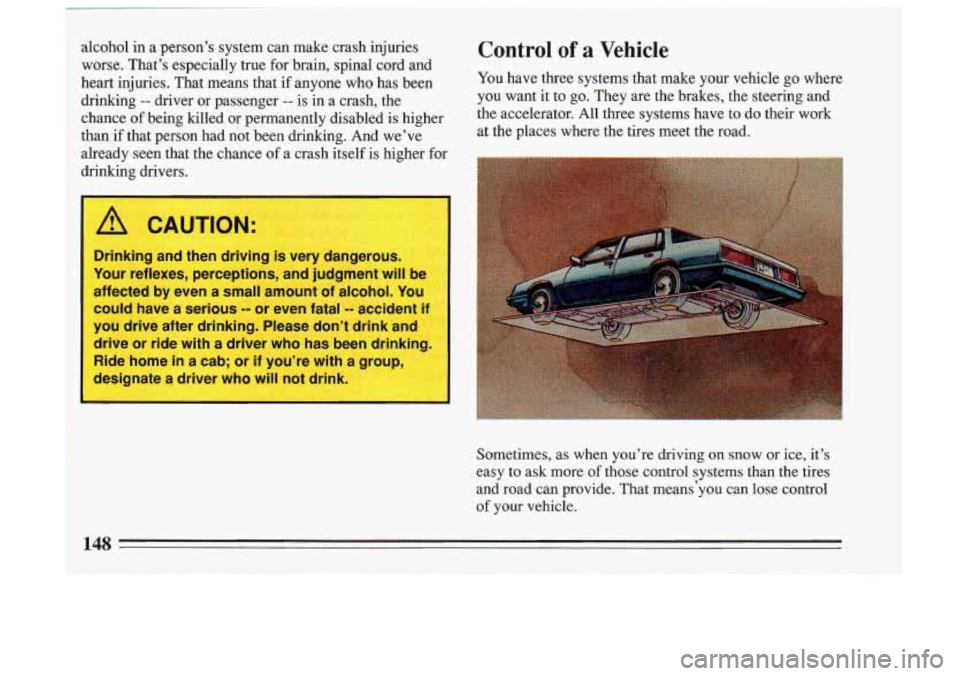
alcohol in a person’s system can make crash injuries Control of a Vehicle
worse. That’s especially true for brain, spinal cord and
heart injuries. That means that if anyone who has been You have three systems that make
your vehicle go where
drinking
-- driver or passenger -- is in a crash, the you want it to go. They are the brakes, the steering and
than if that person had not been drinking. And we’ve
at the places where the tires meet the road.
already seen that the chance of a crash itself is higher for
drinking drivers. chance
of being
filled or permanently disabled is higher the accelerator. All three Systems have to do their work
L
A CAUTION:
-
*. ,
Drinking and then driving is very dangerous.
Your reflexes, perceptions, and judgment will be
affected by even a small amount
of alcohol. You
could have a serious
-- or even fatal -- accident i 1
you drive after drinking. Please don’t drink an
drive or ride with a driver who has been drinking.
1;
Ride home in a cab; or if you’re with a group,
designate
a driver who will not drink.
Sometimes, as when you’re driving on snow or ice, it’s
easy
to ask more of those control systems than the tires
and road can provide. That means‘you can lose control of your vehicle.
148
Page 158 of 306
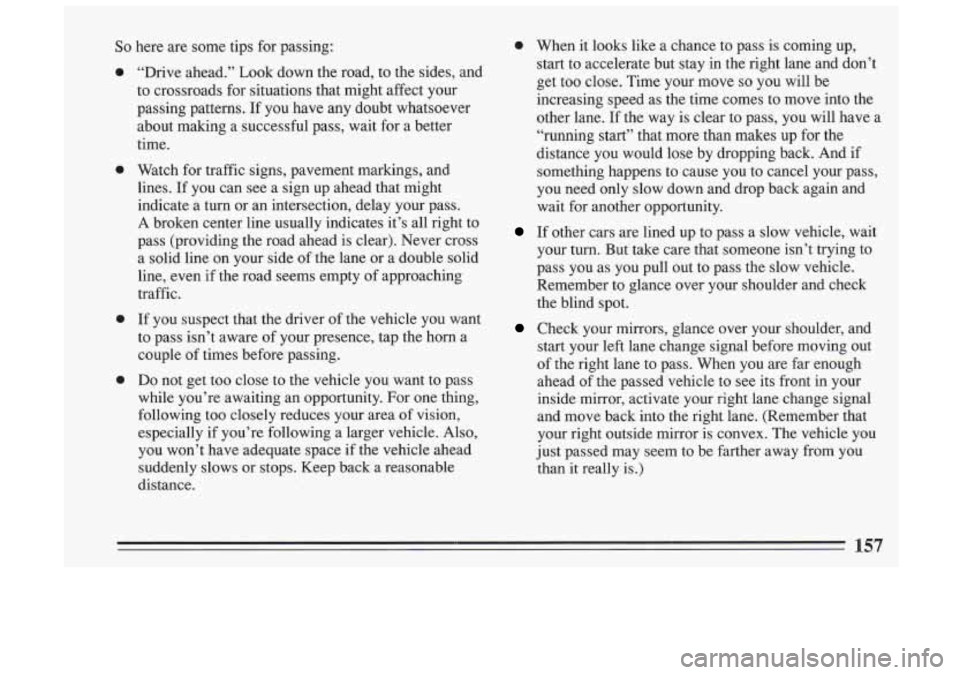
So here are some tips for passing:
0
0
0
0
“Drive ahead.” Look down the road, to the sides, and
to crossroads for situations that might affect your
passing patterns. If you have any doubt whatsoever
about making a successful pass, wait for a better
time.
Watch for traffic signs, pavement markings, and lines. If you can see a sign up ahead that might
indicate a turn or an intersection, delay your pass.
A broken center line usually indicates it’s all right to
pass (providing the road ahead is clear). Never cross
a solid line on your side of the lane or a double solid
line, even if the road seems empty of approaching
traffic.
If you suspect that the driver of the vehicle you want
to pass isn’t aware of your presence, tap the horn a
couple of times before passing.
Do not get too close to the vehicle you want to pass
while you’re awaiting an opportunity. For one thing,
following too closely reduces your area of vision,
especially if you’re following a larger vehicle. Also,
you won’t have adequate space if the vehicle ahead suddenly slows or stops. Keep back a reasonable
distance.
0 When it looks like a chance to pass is coming up,
start to accelerate but stay in the right lane and don’t
get too close. Time your move
so you will be
increasing speed as the time comes to move into the
other lane. If the way is clear to pass, you will have a
“running start” that more than makes up for the
distance you would lose by dropping back. And if
something happens to cause you to cancel your pass,
you need only slow down and drop back again and
wait for another opportunity.
If other cars are lined up to pass a slow vehicle, wait
your turn. But take care that someone isn’t trying to
pass you as you pull out to pass the slow vehicle.
Remember to glance over your shoulder and check
the blind spot.
Check your mirrors, glance over your shoulder, and start your left lane change signal before moving out
of the right lane to pass. When you are far enough
ahead of the passed ‘vehicle to see
its front in your
inside mirror, activate your right lane change signal
and move back into the right lane. (Remember that your right outside mirror is convex. The vehicle you
just passed may seem to be farther away from you
than it really is.)
157